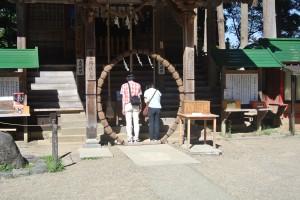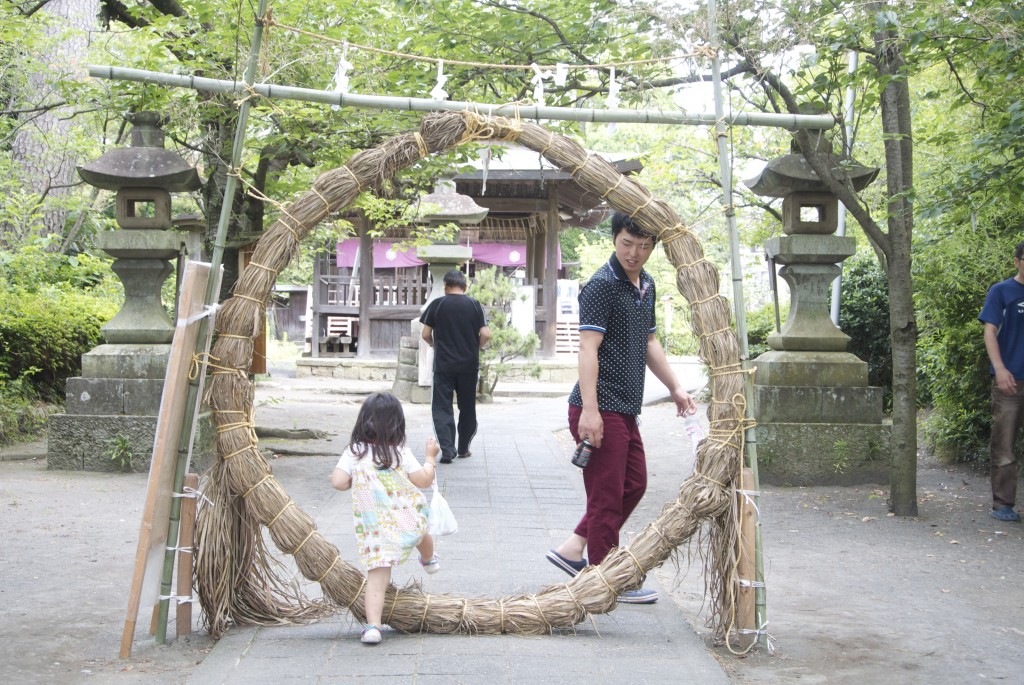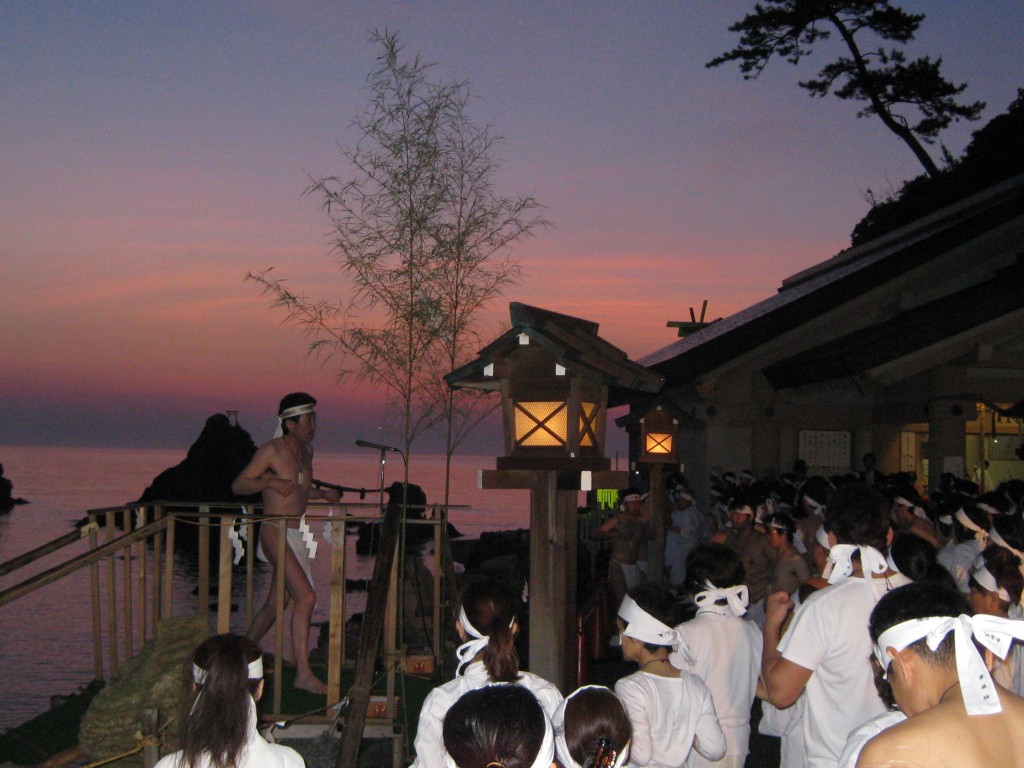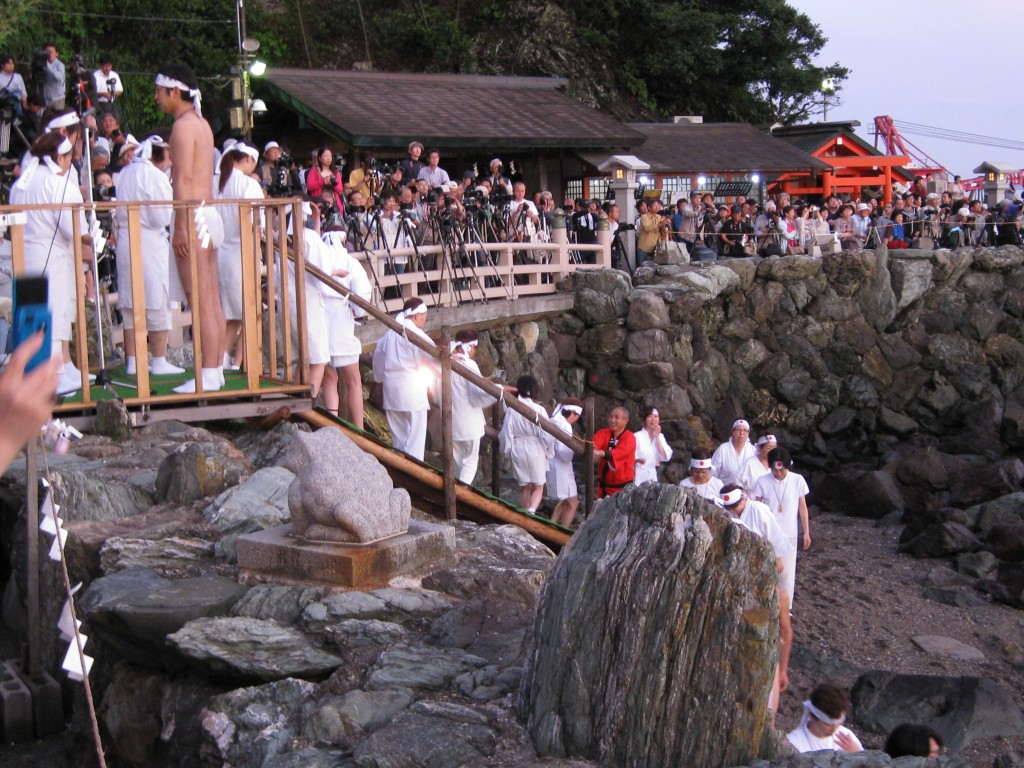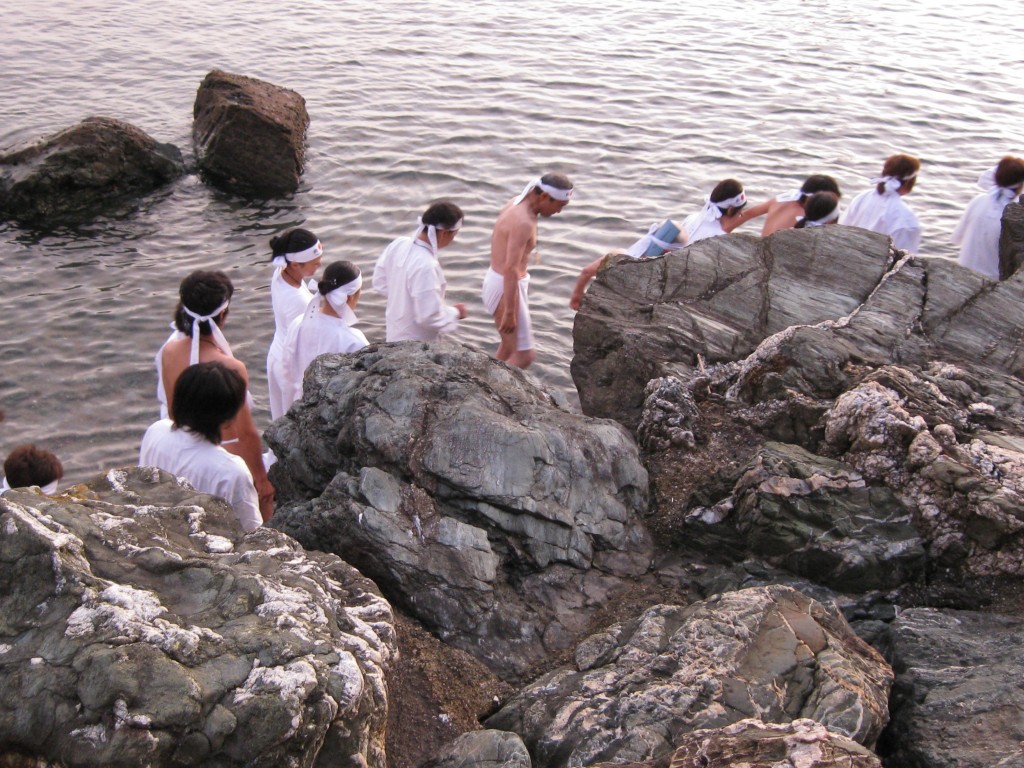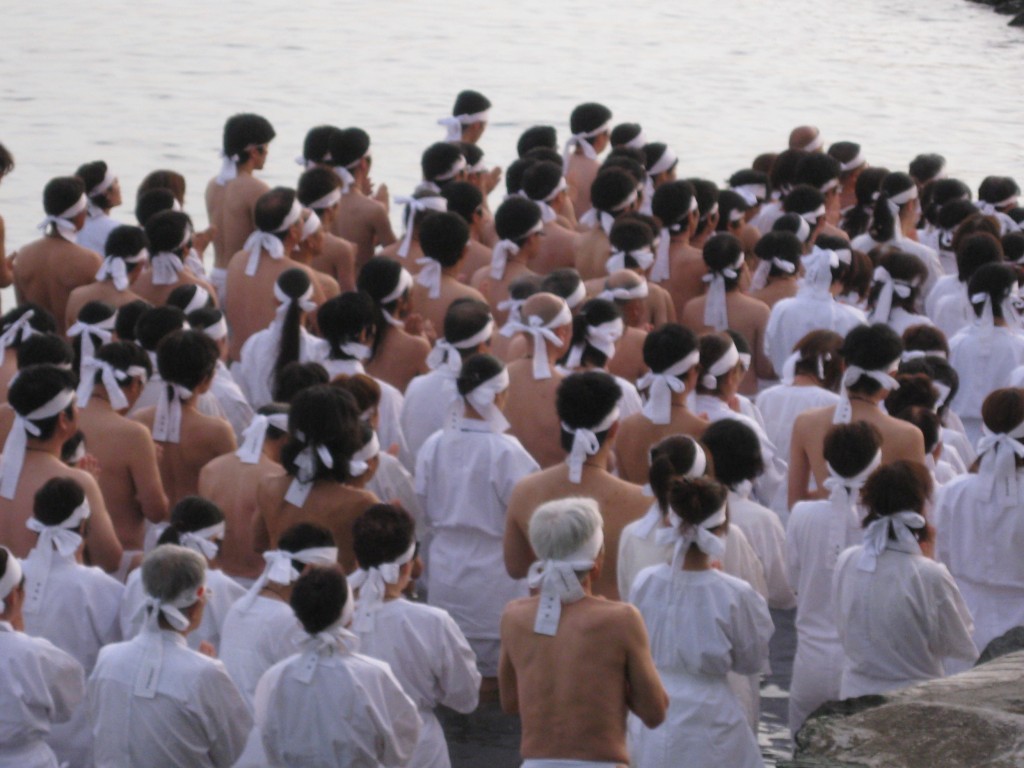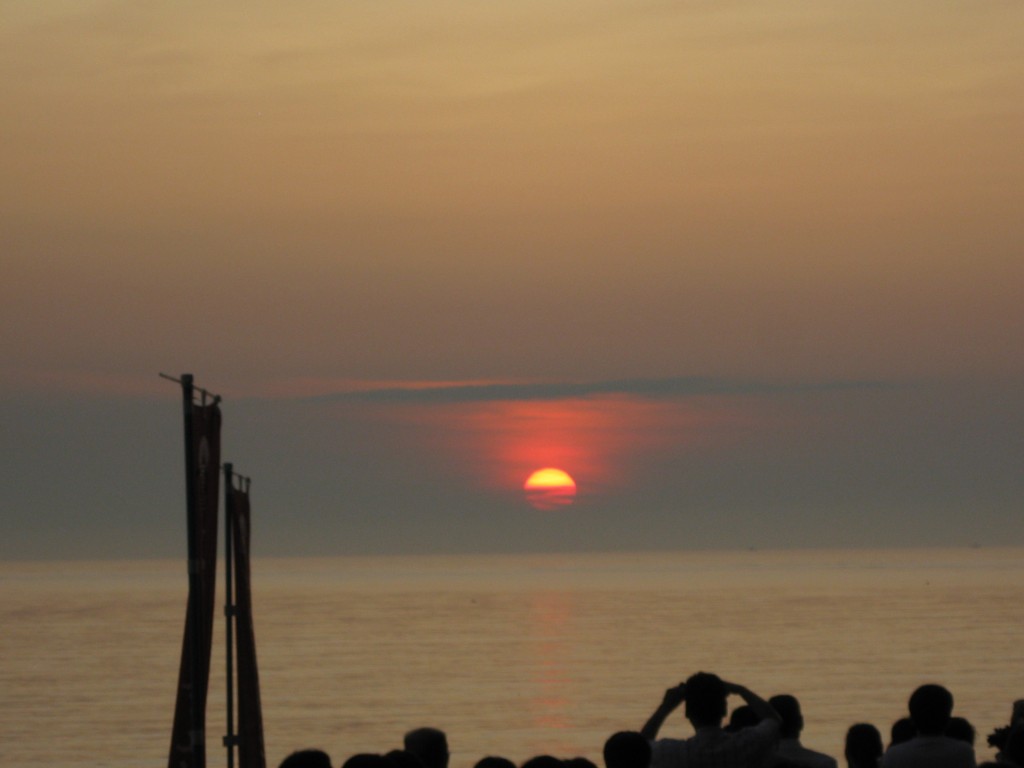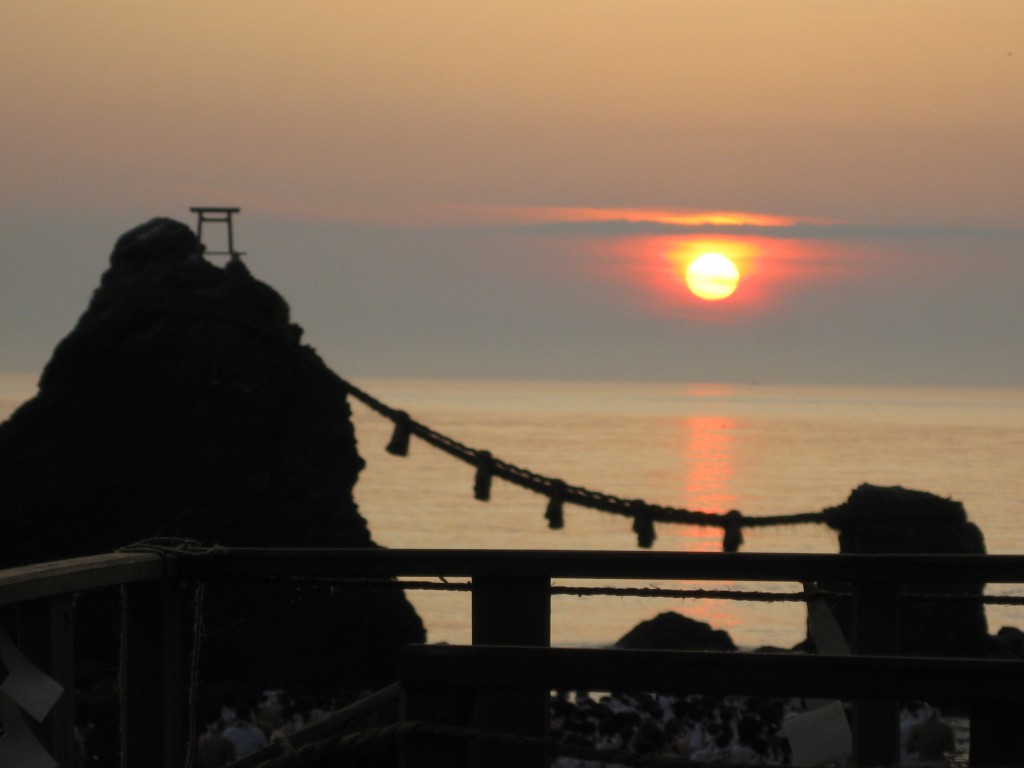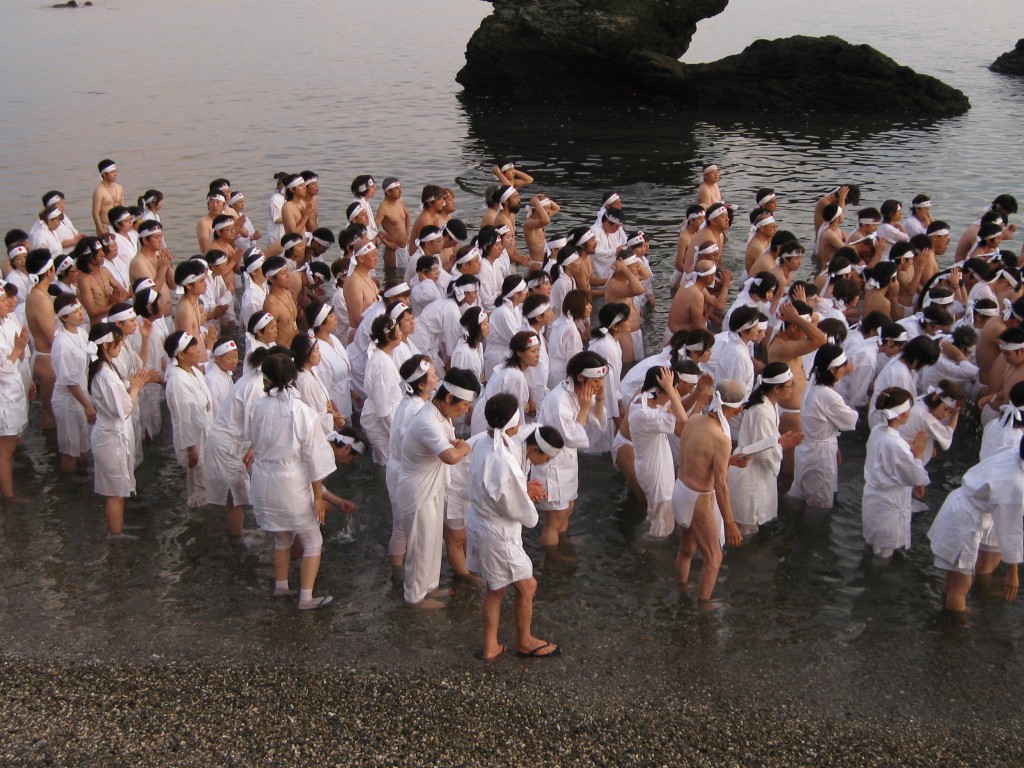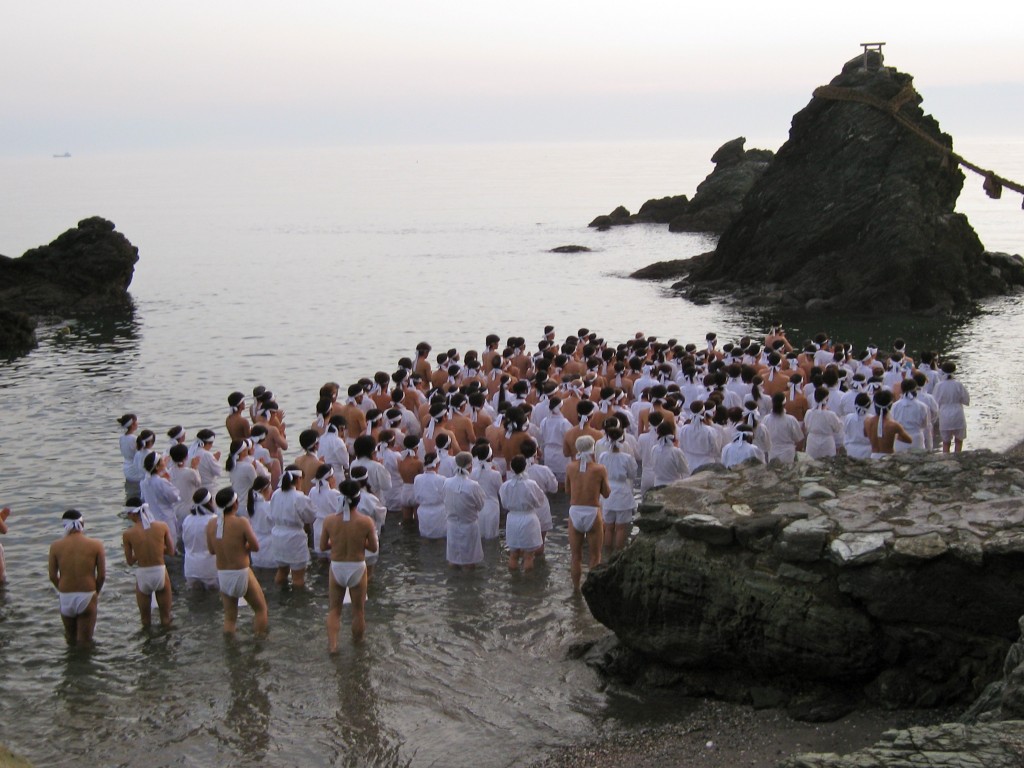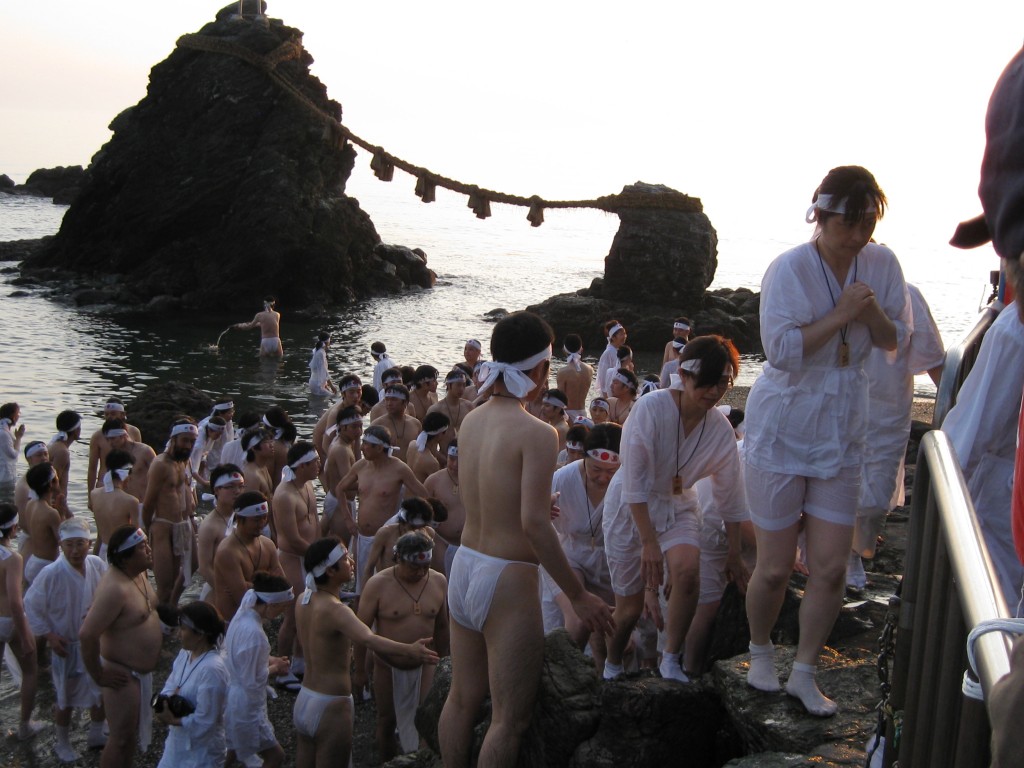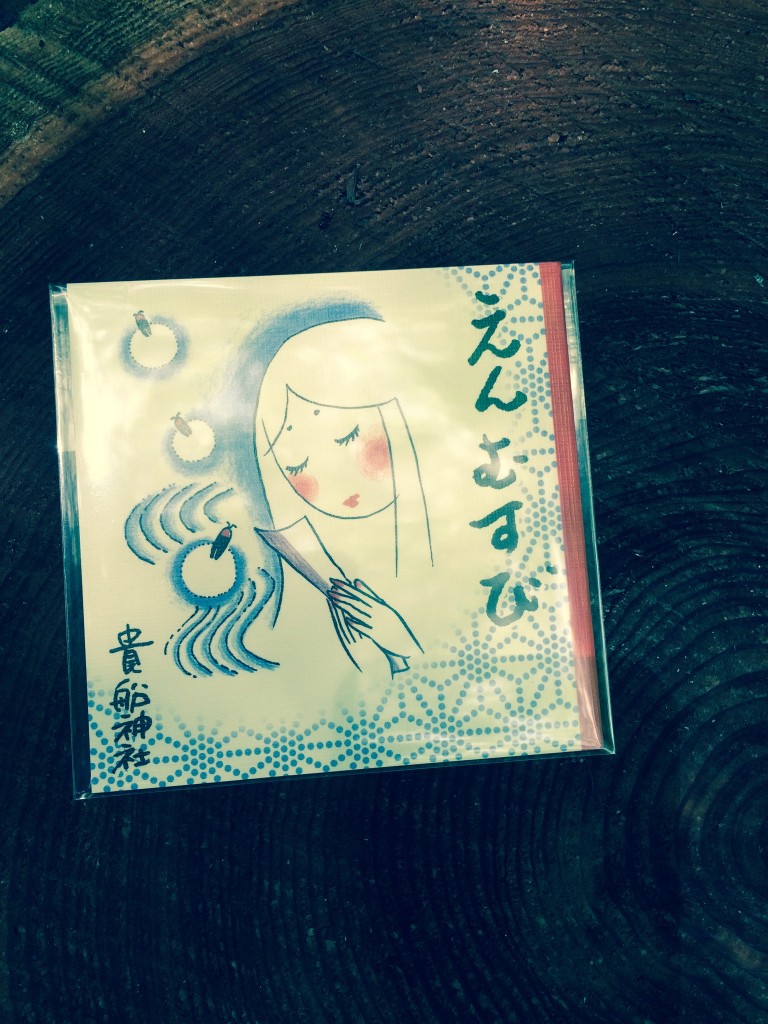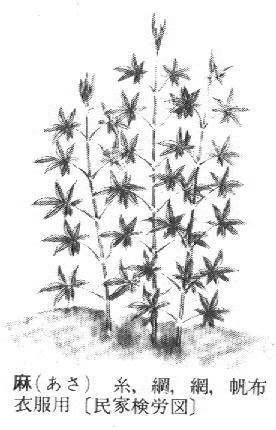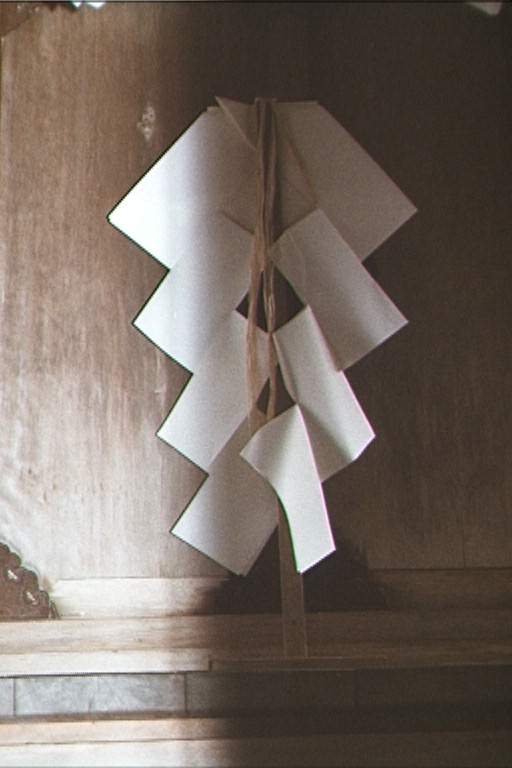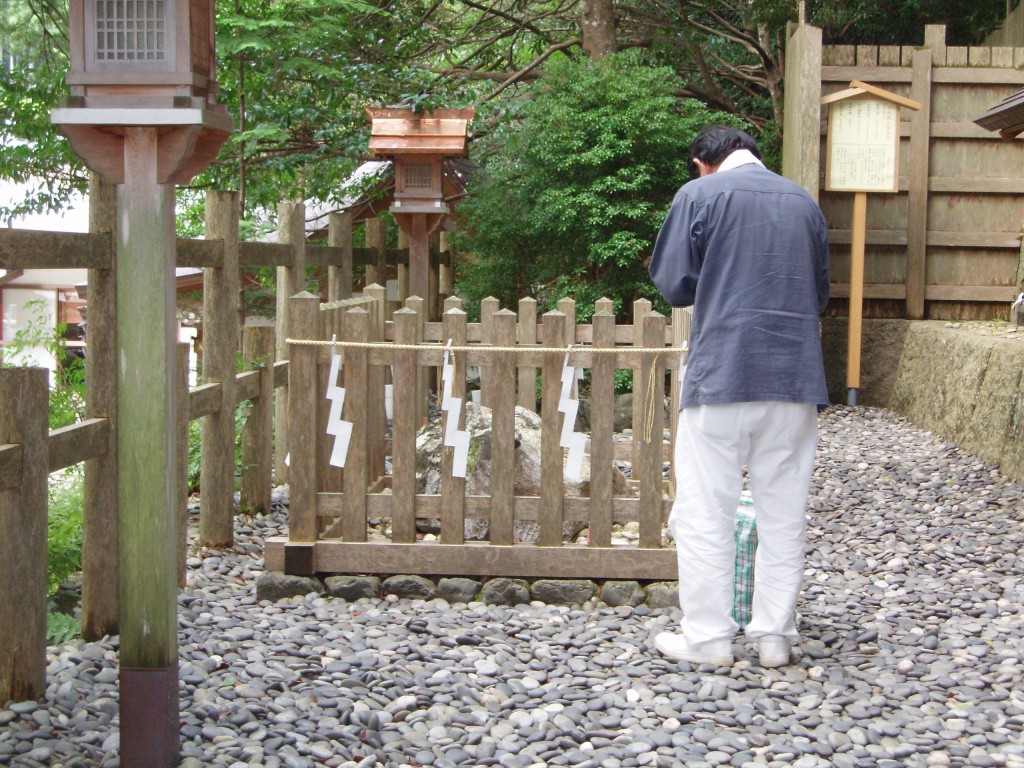
Praying to a sacred rock at Tenkawa Jinja
Westerners are often drawn to the animist side of Shinto, and for those of us who look to the past before the religion was made into an emperor-centred ideology, one of the salient characteristics of early Japan is rock worship. Sacred rocks can be found across the country, and they often form the spiritual heart of ancient shrines. Some indeed are the spirit-body of the kami. Others are held by legend to be the place where a kami descended, or to have formed the original site of worship at the shrine.
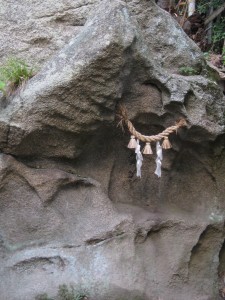 Despite the centrality of rocks to early Shinto, very little is written about them and few pay them much attention. In my experience even the priests know very little about them, since the shamanic powers with which they were once invested have waned over time. Priests nowadays are ritualists, far removed from the shamans of former times. Indeed, I’ve sometimes found embarrassment about the subject, as if it’s a relic from a primitive past.
Despite the centrality of rocks to early Shinto, very little is written about them and few pay them much attention. In my experience even the priests know very little about them, since the shamanic powers with which they were once invested have waned over time. Priests nowadays are ritualists, far removed from the shamans of former times. Indeed, I’ve sometimes found embarrassment about the subject, as if it’s a relic from a primitive past.
Green Shinto readers will be familiar with some of the earlier postings about the nature of rock worship that have appeared here. (See the category for Rocks to the right.) One of the most fruitful areas of investigation into the subject is in the shamanic tradition of other countries – in Korea for instance rock worship is very much still a living practice. The article below from the magazine Sacred Drum looks further afield, to Andean shamanism which treasures the energy and spirit connections of rocks. Given the strong shamanic tradition of early Japan, evident in the likes of Himiko and other female shamans, one can presume that the sacred rocks of old must have been invested with similar sentiments.
**************************************************************
Deborah Bryon, Ph.D. is a licensed psychologist and Jungian Analyst. She completed her undergraduate degree in psychology at UCLA in 1976, and a master’s degree in clinical psychology in 1979. For the last several years she has received in-depth training with Q-ero shamans in Peru. She is the author of ‘Lessons of the Inca Shamans: Piercing the Veil’.
WITH THE LOVE OF STONES
The Mesa Medicine Bundles of Andean Medicine People
by Deborah Bryon
For Andean medicine people, shamanism is the practice of connection in service of their community, and Pachamama (Mother Earth). Everything in nature is living and works together, a relationship they refer to as ayni.
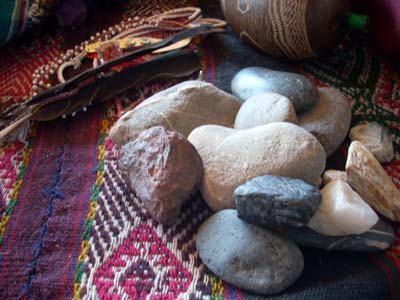
An Andean shaman's 'mesa' collection of sacred stones (courtesy Billie Dean)
P’aqos [shamans] feed their connection with Pachamama in rituals and ceremony, in a practice that involves working with a mesa, or medicine body. The actual mesa is a collection of stones, individually found in nature, that the p’aqo feels an energetic affinity towards.
A p’aqo’s mesa has multiple functions. Through them, p’aqos become anchored to the earth and increase their capacity to hold energy in healing and communication with the mountain spirits. The mesa also serves as an intermediary gateway to the spirit world. A mesa‘s power is a function of the strength of the p’aqo’s energetic connection with Pachamama.
If a stone is suitable for a p’aqo’s mesa, the p’aqo will detect an energetic vibration that resonates with their energy body when they hold the stone in their hand or against their solar plexus. The stone may not look particularly unusual, but the p’aqo will intuitively sense a ‘pull’ to the stone that feels ‘right.’ Stones that become part of a mesa then become referred to as q’uiyas.
Sometimes a q’uiya chooses us. Q’uiyas can appear suddenly in our path. They can also disappear from our mesas when our work together is complete, and it is time for us to say goodbye.
Building a mesa is an act of love, and q’uiyas – like mates – should be chosen very carefully. It is important that the stone not be missing limbs, not chipped and with no missing pieces. Like the human form, it helps if the shape or aesthetic form of a q’uiya is unified and complete. Q’uiyas must be capable of holding energy – as well as information.
When a p’aqo decides to bring a new stone into a mesa, they set the intention to weave the q’uiya into their energy body. An energetic exchange is established between the q’uiya and the p’aqo through connecting with it in the three major energy centers located in the belly, heart, and mind. A p’aqo can begin to develop this connection by observing what they are experiencing in their energy centers, starting with the belly, and visualising the energy center expanding with light and energy.
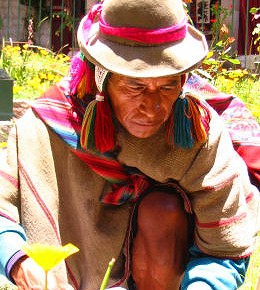
Peruvian shaman (courtesy Nichola Fiorito)
Once the energy center has been opened, the p’aqo visualises the energy moving in a figure of eight pattern between the q’uiya and the energy center in the belly. Once the energy connection in the belly is made, the p’aqo repeats this process by placing the stone over the heart center, and then again touching the energy center of the mind located in the forehead.
Over time this practice comes to be automatic and a p’aqo will be able to sense a connection almost immediately.
When a stone becomes a q’uiya, it becomes a sacred object. A q’uiya stone is a living being that is a member of the p’aqo’s medicine body. The sacred stones are energetically blended together to form a rich tapestry connecting the energy body to Pachamama, and the spirit world.
Bringing a new q’uiya into a mesa is similar to bringing a new member into a family. Everyone must get along and work together. Each q’uiya has its own location in an open mesa, similar to each member of a family having a seat at the dinner table.
Mesas stones usually evolve organically into a specific formation as unique energetic affinities between stones emerge. Individual q’uiyas have a unique energetic vibration that resonates at a certain frequency, depending on their natural qualities. This dynamic relationship between q’uiya stones develops either as a union of opposites balancing masculine and feminine energy (yanantin), or through an alignment of similar energy.
Energetically, a balanced mesa is similar to a well-tuned orchestra. The energetic expression of the q’uiyas combined creates a symphony of power and wholeness.
Mesas can provide us with deep wisdom if we take the time to listen. A q’uiya stone can become an important teacher. Each stone is imprinted with information and energy that we discover as our knowledge and understanding of the q’uiya deepens. A p’aqo‘s relationship with a mesa is a love affair, and as in any significant intimate relationship, it requires attention in order to grow and thrive.
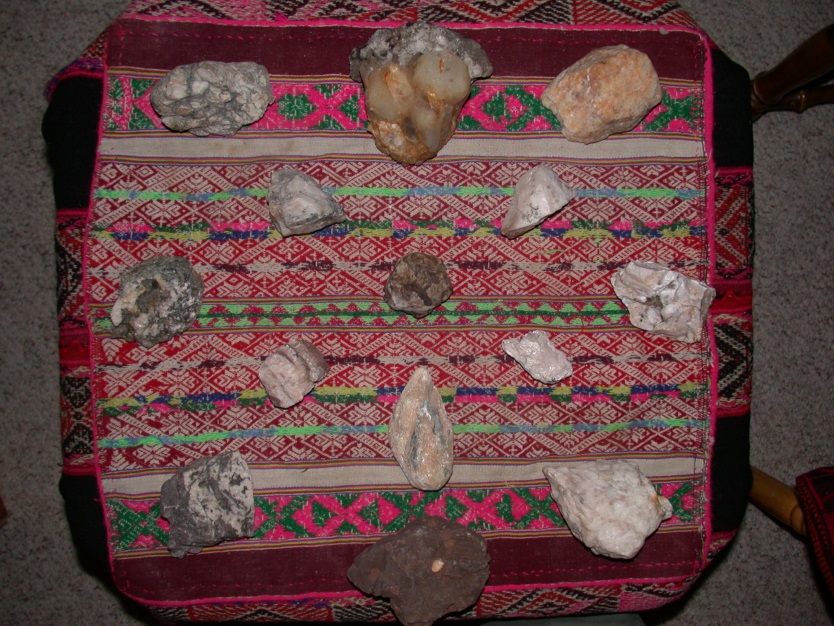
A collection of q’uiyas, or sacred stones (courtesy Deborah Bryan)
Caring for a mesa is also like tending to a young child – or any living being for that matter – it needs to be fed, purified, listened to, and treated with respect. We feed our mesas with love and intention, sitting with them and giving them our full attention. I have found it is easiest to connect with my mesa when I am in nature, the place where it is easiest for me to shift into communicating with the spirit world.
Working with a mesa often begins with ‘opening sacred space’ and ‘breathing in’ the energy of the surrounding natural world. I have done this quietly sitting under the large draping willow tree in my yard. Being wrapped in a waterfall of cascading leaves that reach down and touch the earth while taking in the timeless strength of the willow’s magnificent trunk is a way for me to re-member myself in my body.
As a p’aqo’s understanding of the practice of Andean medicine deepens, they may begin to work with multiple mesas, each with specific functions. Collective mesas that are an expression of an ayllu that can be used in ceremony. Some mesas are used for healing and removing negative energy. In the mesa I use for healing, each q’uiya holds a unique vibration of their own separate from a relationship I have formed with the stones.
In my personal mesa, I currently have twelve stones, six of which have become united in pairs. Through yanantin, pairs of masculine and a feminine q’uiyas have become joined. Although I may or may not have a contextual sense of where each of the stones in my mesa are from, the q’uiyas feel as though they are all from different places, each with their own history and lineage.
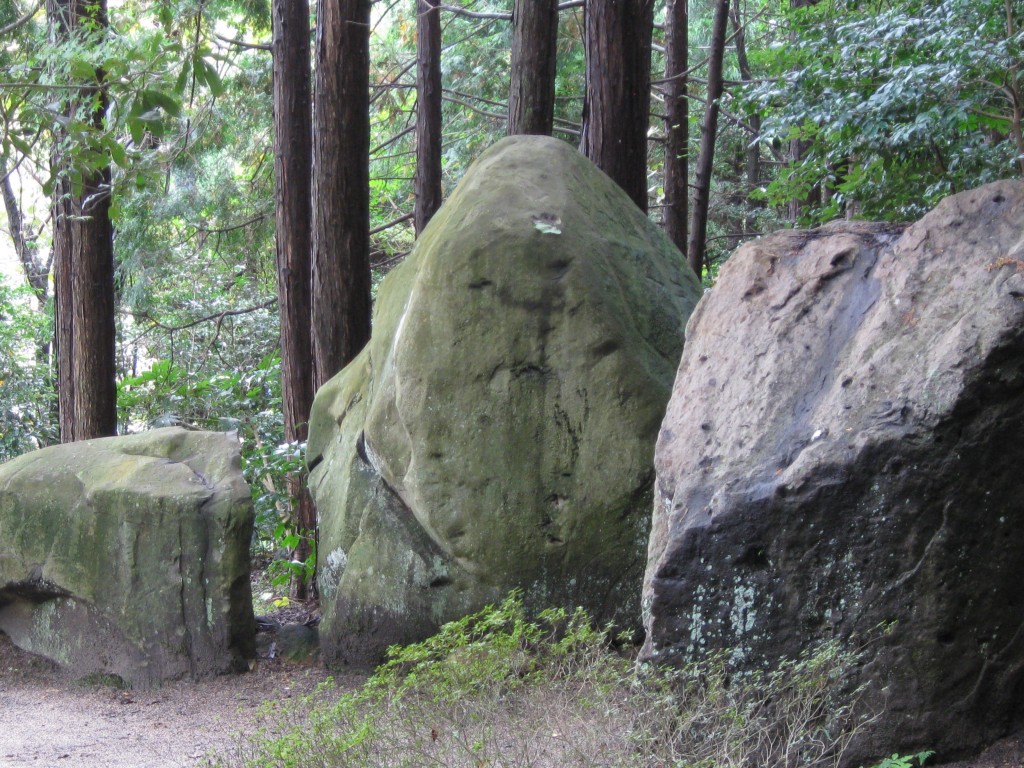
Yamotsu Hirasaka - according to tradition, the rock with which Izanagi blocked up the lower world when he escaped from Izanami's rotting corpse in the Kojiki mythology
In my mesa, two of the q’uiyas carry the energy of the lower world. One q’uiya conveys the deep, fertile feminine energy of the Amazon Jungle, while the other transmits the masculine energy of the wind. When I tune in to each stone, I can feel their essence in my body. I feel the movement and power of the wind protectively circling around me, while the q’uiya of the Amazon feels very old, very dark, and very, very still. Sometimes when I am holding the stone, I have the comforting sensation of being buried deep in the earth.
The stones of the middle world, feel different to me. I associate the masculine stone with my ally who I refer to as ‘Birdman’ because he appears to me in that form in vision states. The upper world stones are the most difficult for me to describe because I experience them as being in the energetic realm. To sense their energy, I must energetically extend my energy bubble) far above my head, expanding into light – way beyond where I can picture seeing.
When I am connected with the masculine q’uiya of the upper world, I can feel myself moving way up into the clouds, and looking down on a massive summit of energy. I often sense that there are white energetic beings surrounding me, even though I cannot see them. Their range is beyond what I am capable of describing accurately using words – I can only feel.
When I tune into the feminine stone of the upper world, it feels that I have passed through energetic bands or levels, and I am in a place that is very still. I sense this state as pure white light that is somehow contained.
Moving through the energy channel provided through my mesa enables me to experience energetic activity with beings whose presence I can somehow only vaguely sense. Sometimes, it can feel as if I am in deep sleep-yet I know that I am not because I am focusing.
We enter into relationship with the spirit world when we are listening to the rustling of leaves or the soft gradual beat of rain, when we are watching birds appearing suddenly overhead, smelling the moist earth, or are tuning into the life force of the wind. These experiential states are accessed through feeling, not analysing. The mesa is a powerful conduit that enables a p’aqo to enter into other spiritual dimensions beyond physical reality.
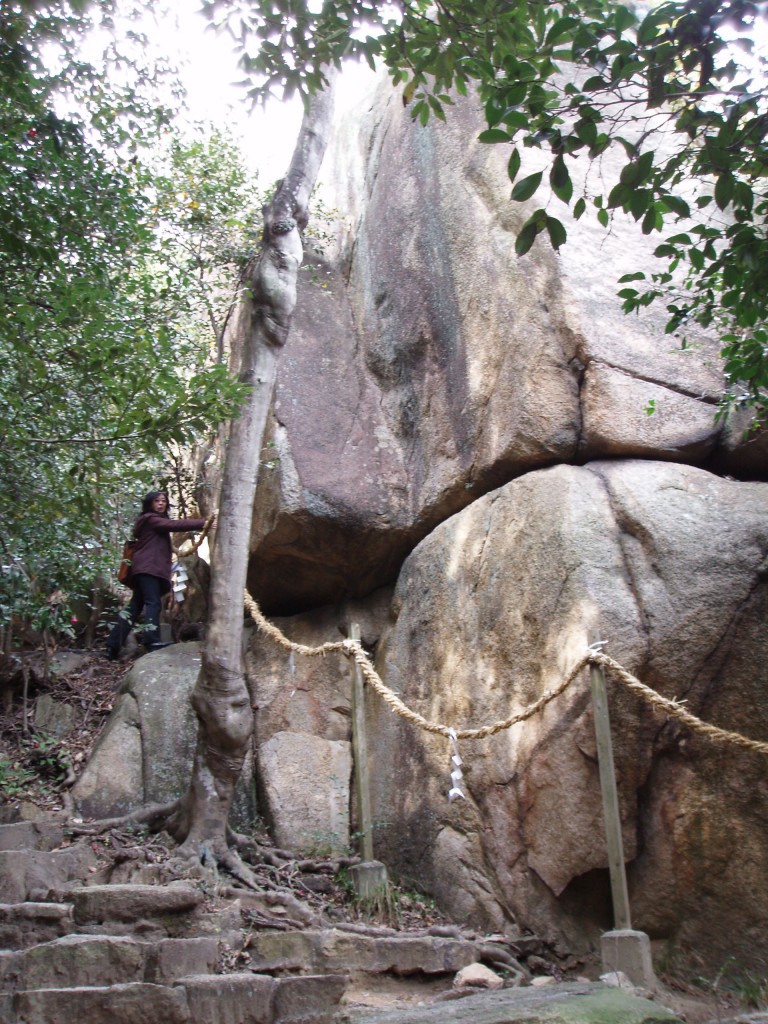
Rocks have the power to transport us into spiritual dimensions beyond physical reality

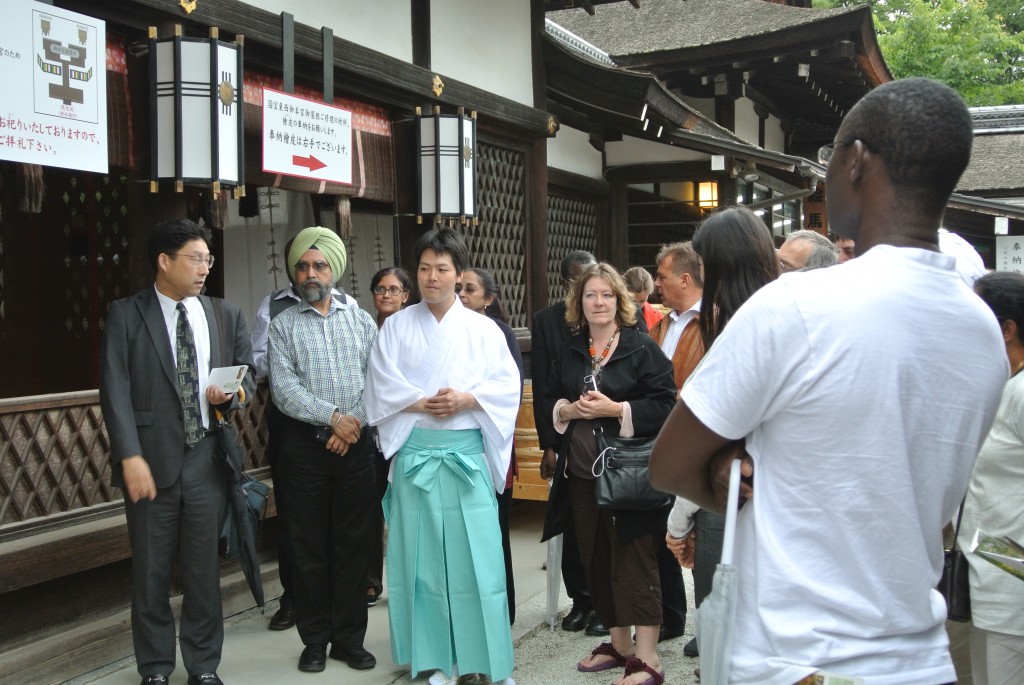
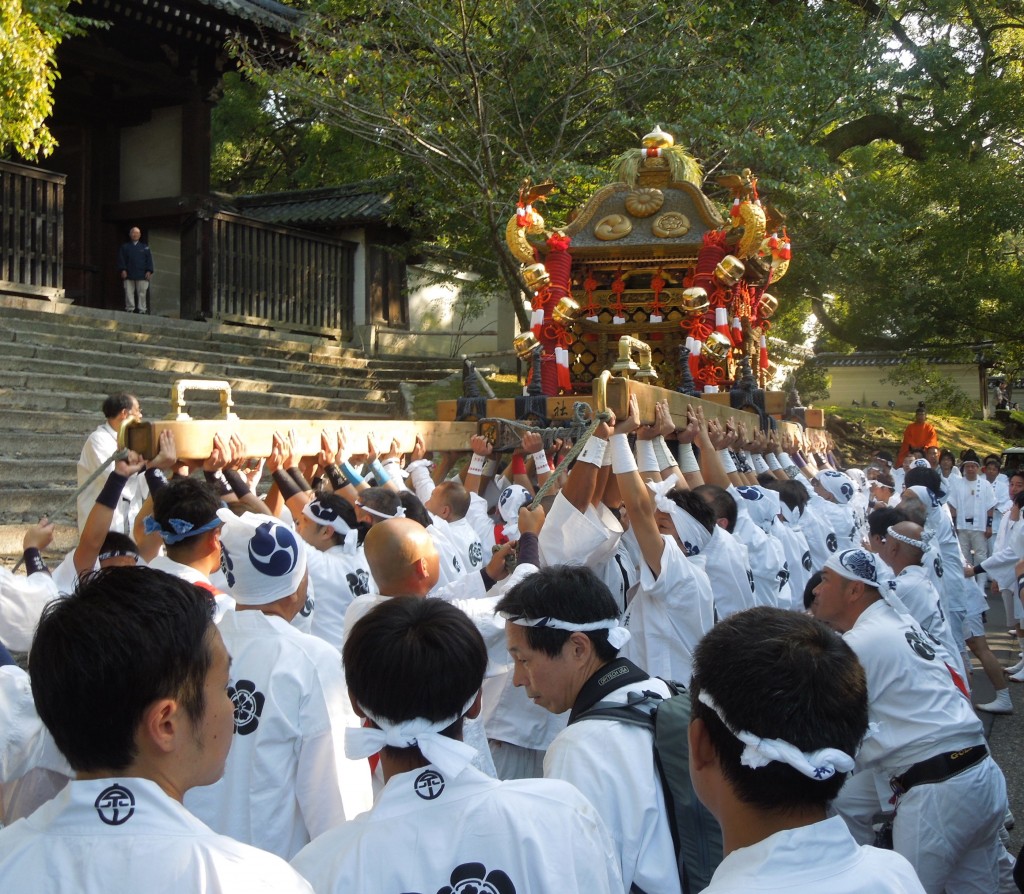

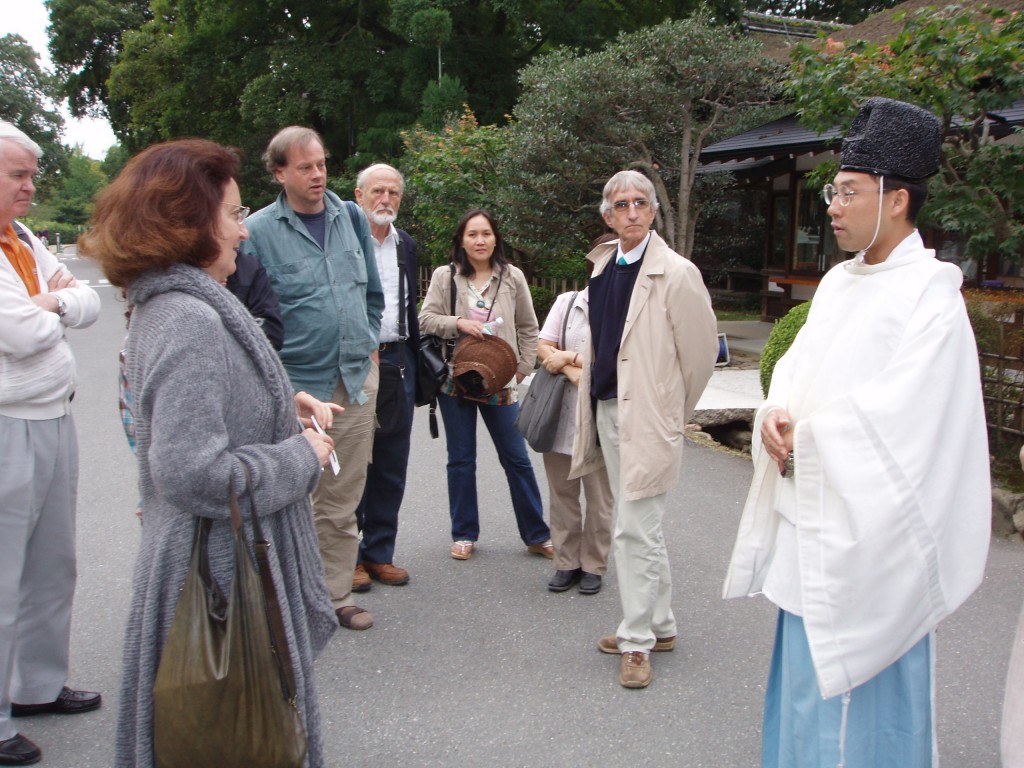
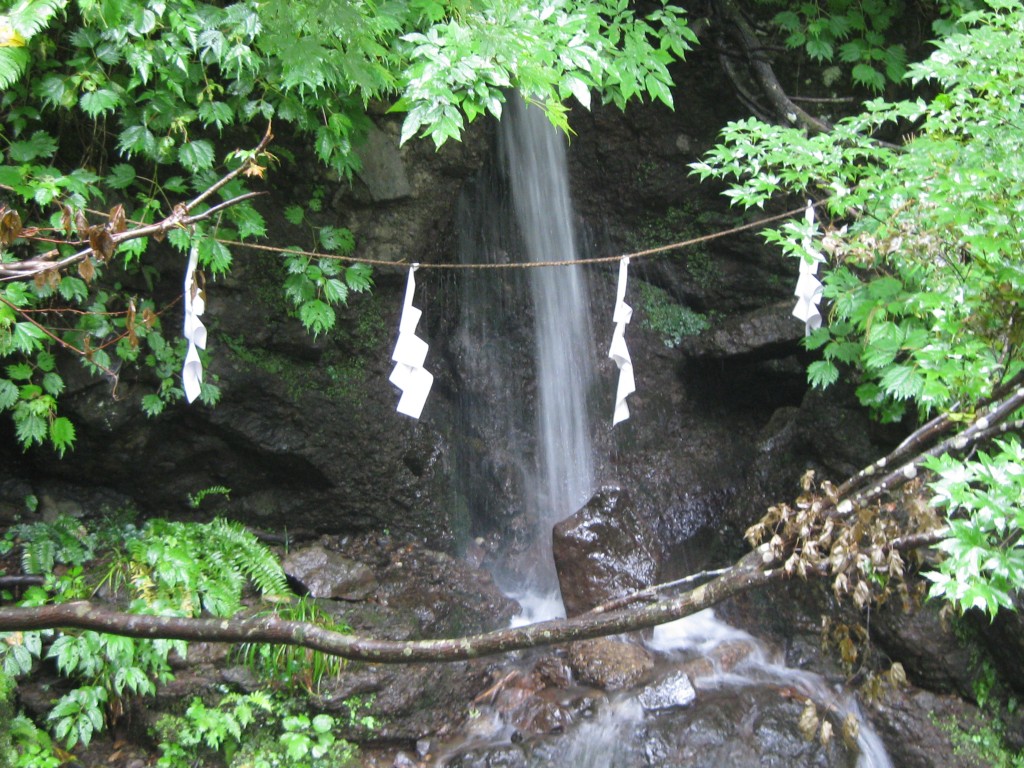
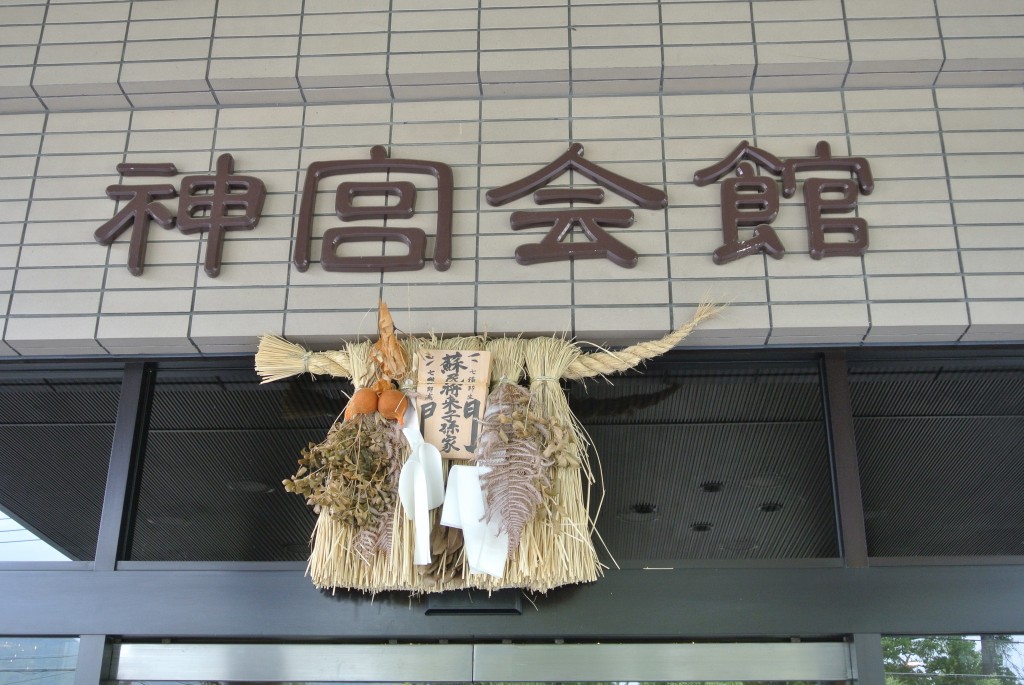
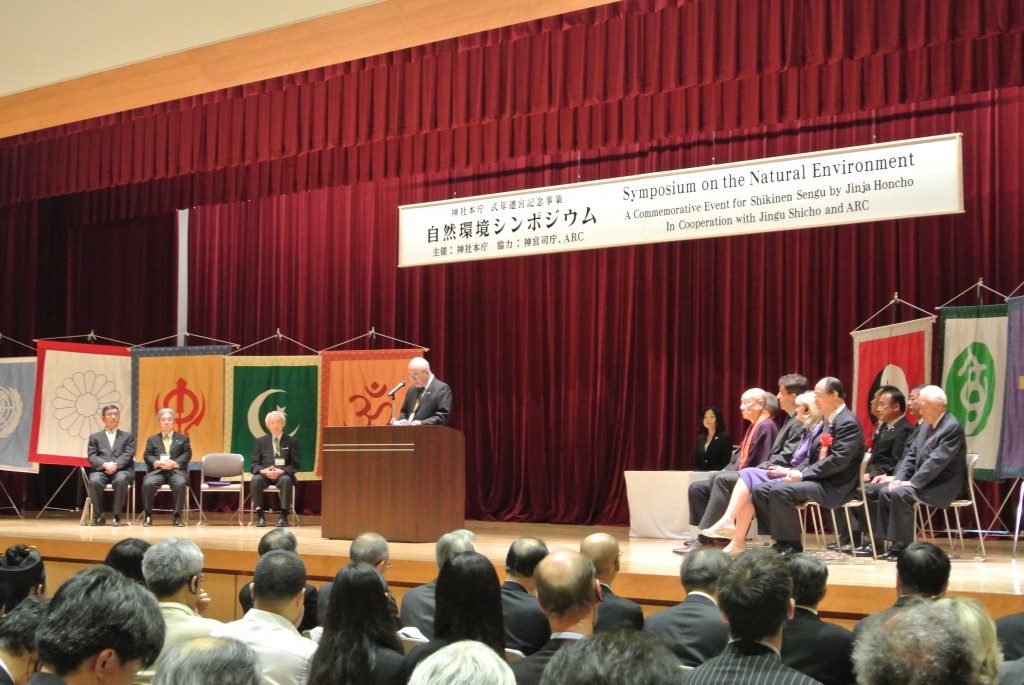
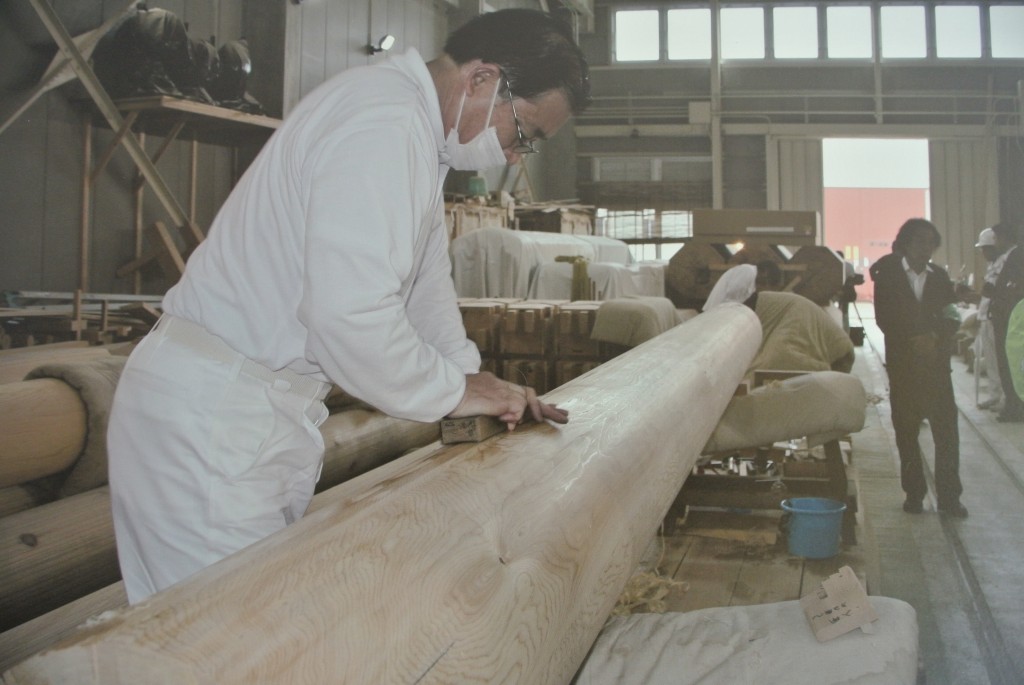
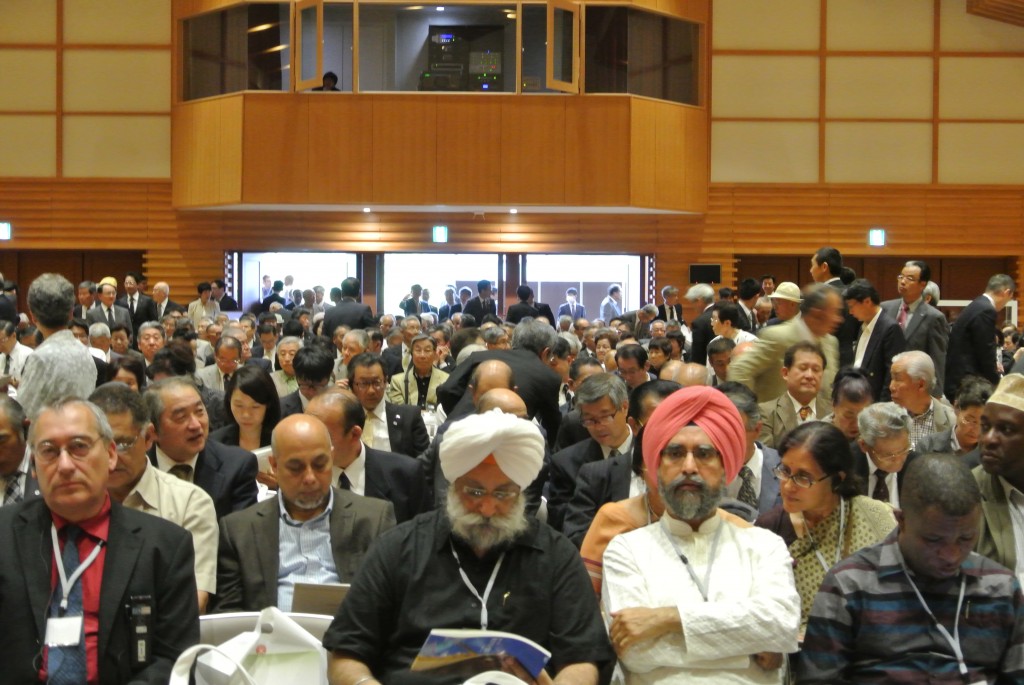
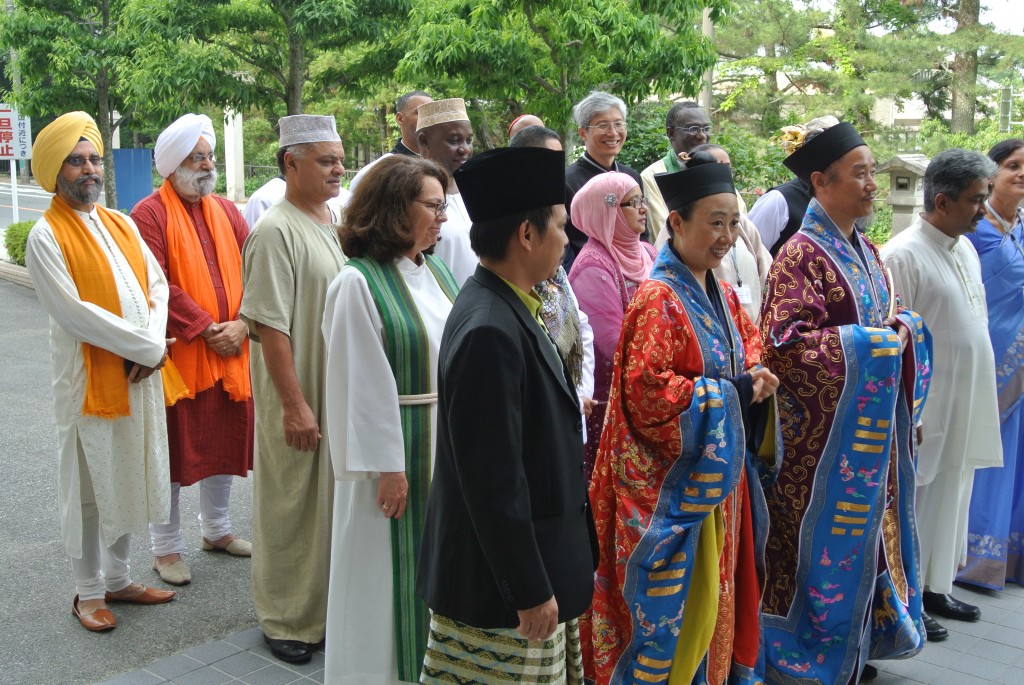
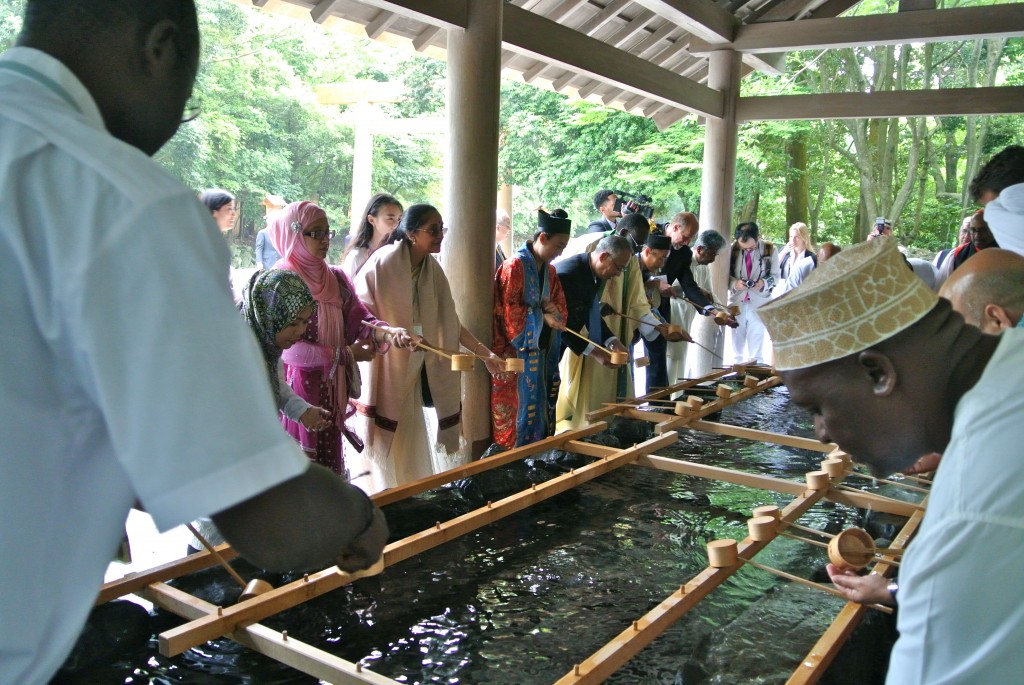
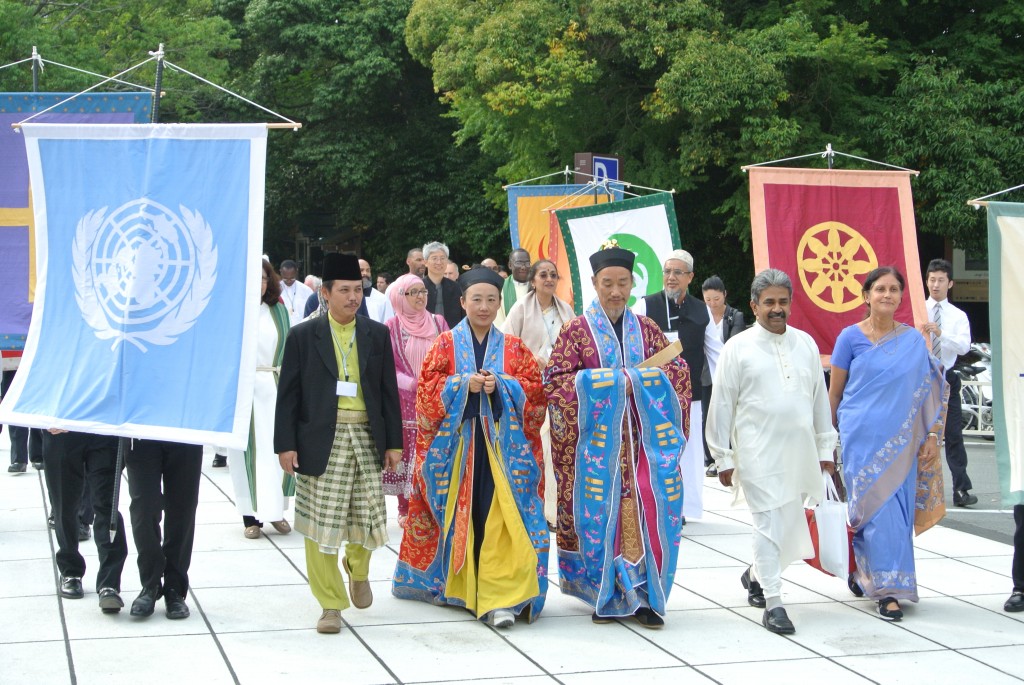 ARC
ARC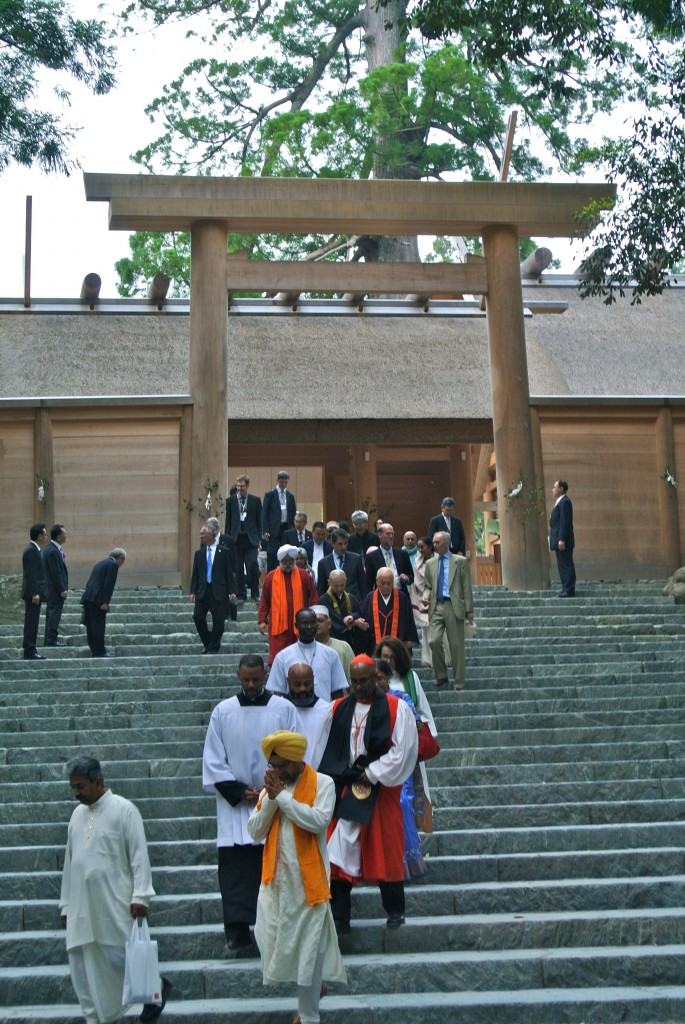 Messages of support
Messages of support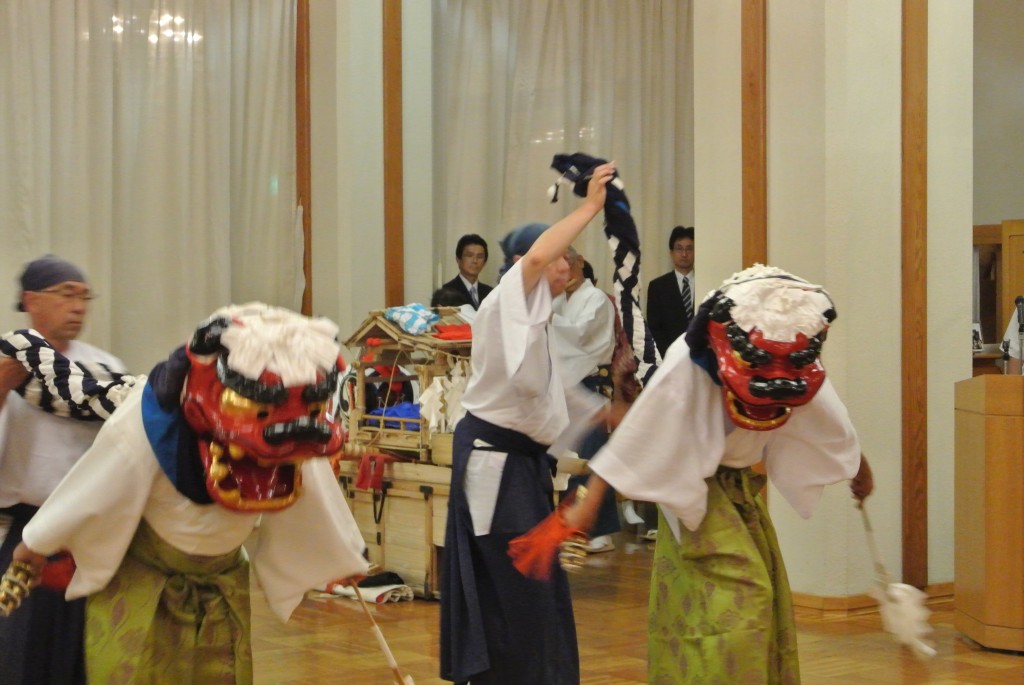
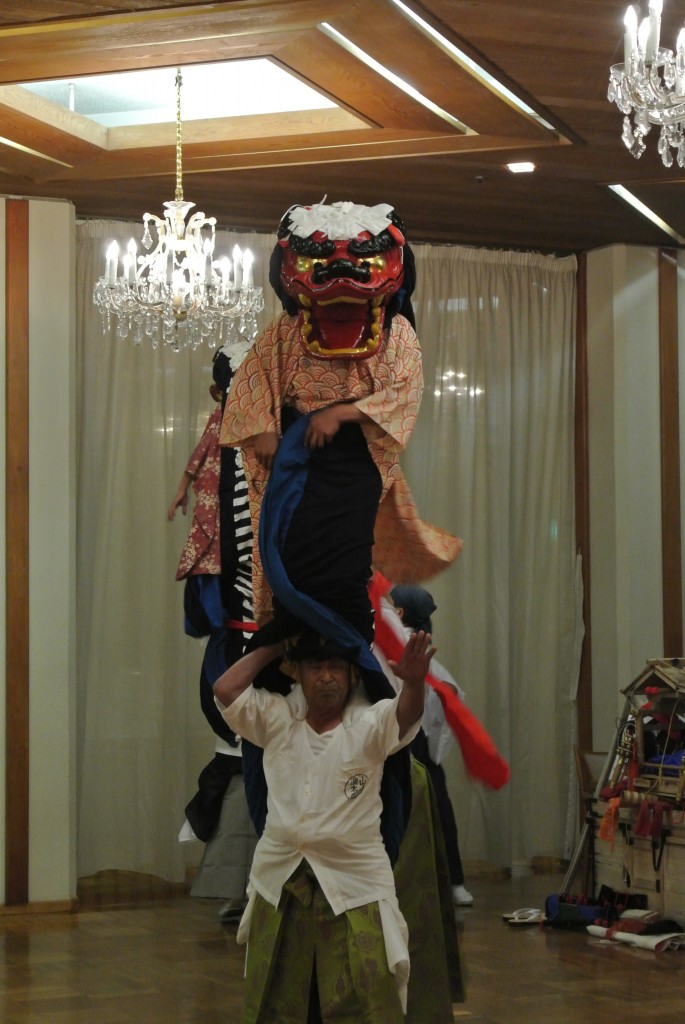
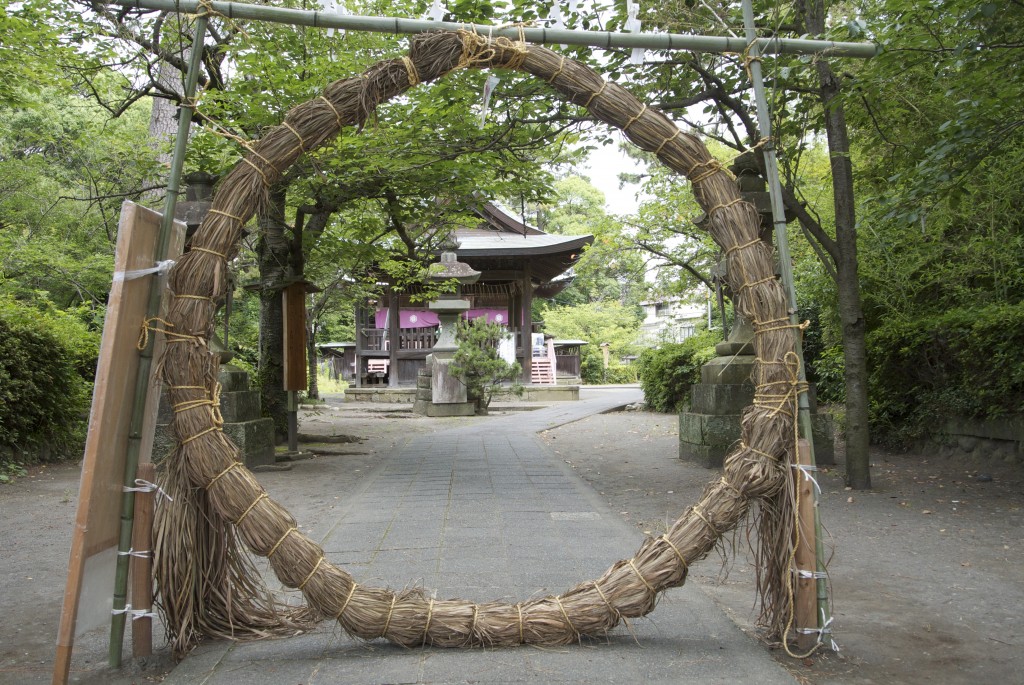
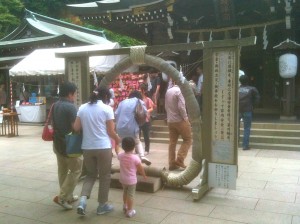 Chinowa is “a large ring made of cogon grass (chigaya) and erected on the pathway leading to a shrine on the days of purification (harae) of the last day of the sixth or seventh month. Worshipers at the shrine pass through the ring as an act of purification from misdeeds (tsumi), impurities (kegare), or bad luck. An extant fragment from the ancient gazetteer of the province of Bingo relates the tale of Somin Shōrai, a legendary hero who tied a magical ring braided of cogon grass around his waist and thus escaped an epidemic. In ancient times the ring of woven grass was attached to the waist or hung around the neck.
Chinowa is “a large ring made of cogon grass (chigaya) and erected on the pathway leading to a shrine on the days of purification (harae) of the last day of the sixth or seventh month. Worshipers at the shrine pass through the ring as an act of purification from misdeeds (tsumi), impurities (kegare), or bad luck. An extant fragment from the ancient gazetteer of the province of Bingo relates the tale of Somin Shōrai, a legendary hero who tied a magical ring braided of cogon grass around his waist and thus escaped an epidemic. In ancient times the ring of woven grass was attached to the waist or hung around the neck.